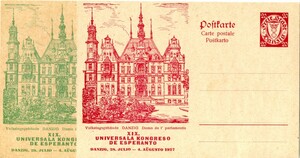A PLETHORA OF PLEBISCITES

Germany's boundaries were always fluid, containing a good scattering of non-German speakers at the edges. The Versailles Congress of 1919 had a job on its hands. Plebiscites were to be held in the affected areas, with mapping, peace keeping and administration of the plebiscites in the hands of a thin international force. All would be fair and peaceful (?).
Imagine we're looking at a map, let's rotate round Germany clockwise :
SCHLESWIG was divided into Zone I (which adjoined Denmark) and Zone II (the next slice below), based on the known distribution of Danish and of German speakers. Zone III, nearest to Germany, did not participate in the Plebiscite, as virtually all inhabitants there were German speakers. Zone I voted for Denmark (75%) against a minority (25%) for Germany. Zone II was 80% for Germany, 20% for Denmark. So, Zone I returned to Denmark, Zones II and III stayed in Germany.
DANZIG is treated as a plebiscite territory by collectors, because it issued stamps in its own right, but never had a plebiscite. Though largely German-speaking, it was held to be of strategic importance for Poland as an export/import seaport, and was made a free city. It lasted this way until taken over by Germany in 1939.
ALLENSTEIN and MARIENWERDER had a mixed German and Polish population, Marienwerder (south of Danzig) 80% German, Allenstein (adjoining, further east) roughly 50:50. Despite the nominal Plebiscite Commission, the administration remained in the hands of Germans, who applied political and economic force to dissuade the Polish-speakers from voting. Even the stamps for Allenstein were simply Germania stamps with an ALLENSTEIN overprint. Many Poles therefore boycotted the Plebiscite. At the same time, Poland was at war with Bolshevist Russia, and many Poles felt they would be better off (well, relatively) under German rule. Marienwerder voted 92% for Germany, while Allenstein (with almost half Polish speakers) voted 98% for Germany. This surprising victory was achieved not only by economic pressure and intimidation, but helped by Germans voting in several locations. The election administrators were German speakers, who destroyed pro-Polish voting cards or declared them invalid. Dead German voters also somehow managed to cast their votes, unopposed by officials! So, both territories then returned to Germany.
MEMEL never had a plebiscite either. The port, railways and administration were virtually all in German hands, but the population was roughly 50% Lithuanian speaking. The overseeing French Commission wanted to resurrect a Polish-Lithuanian union; the Poles had an interest in Memel as a commercial port. In 1919 the Poles had captured Vilna, once the capital of Lithuania, which raised Lithuanian hostilities to a level that French diplomacy could never influence. Therefore in January 1923 Lithuanian militia simply seized Memel.
UPPER SILESIA is the corner between Germany, Austria and Poland. Many years an important industrial centre, it was dominated by German technology and finance but run using Polish labour. Inevitably the districts closest to Germany were pro-German, while further east the Polish speakers predominated.
As the 1921 plebiscite approached, there were several major uprisings by militia on both sides. Roughly 60% of votes went to Germany and 40% to Poland. However, the unrest continued, and eventually the League of Nations made their own decision. Thereby Poland gained one third of Silesian territory, half the population, but about 80% of the factories. Polish Silesia was only gradually integrated into Poland, retaining German currency until the end of inflation in 1924.
EAST SILESIA (formerly part of Austrian Galicia) is included in our list because this similar neighbouring disputed territory saw overprints on Polish and Czech stamps, depending on military occupation followed by (sometimes contrary) diplomacy.
SAAR (or SAARGEBIET as generally expressed on the stamps of this period) was the rich industrial steel and coal basin occupied by France after WWI, the spoils of the victor. As the leading member of the League of Nations, France decided their occupation would last at least 15 years, followed by an eventual plebiscite. As the 1935 showdown approached, pro-German Nazis increased propaganda and intimidation. A threefold choice lay on the election cards : Germany, France, or to remain administered by the League of Nations. Return to Germany received 90% of the vote, and continuation with the League of Nations 9%. This latter vote probably came from local socialists who opposed the Nazis.
- Published
- 19/05/23 07:04:00 AM
